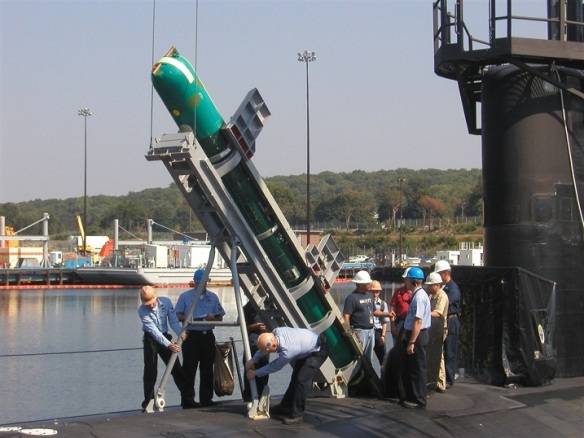The AN/BLQ-11 was a heavy weight autonomous Unmanned Undersea Vehicle (formerly known as the Long-Term Mine Reconnaissance System (LMRS)) manufactured by Boeing. The 20 foot long vehicle was designed to be launched and recovered from an attack submarine (SSN) for covert mine countermeasures.
Features
The AN/BLQ-11 comprises several elements in addition to the actual UUV itself. The system built by Boeing for the U. S. Navy comprises two 20-foot-long, 21-inch-diameter, torpedo-shaped UUVs, a 60- foot robotic recovery arm, onboard handling equipment, support electronics, a shore-based depot, and a specialized van for vehicle transportation.
The AN/BLQ-11 is fully autonomous and untethered, meaning that it can be sent on missions for several hours while the host submarine conducts other missions of its own. It is also designed for full launch, recovery, and maintenance from Los Angeles- and Virginia-class sub marines, using existing torpedo tubes as the launch technique. Four support personnel install, maintain, and utilize the system during operations. A typical mission is 40 hours, with each UUV alternated three times for a total of six separate sorties. During this time, the AN/BLQ-11 can cover a search area of 400 square nautical miles in its search for enemy mines.
The components of the AN/BLQ-11 UUV include a propulsion section, ballast and trim section, forward and aft electronics, side-look sonar (SLS) section, and forward-looking sonar at the front of the UUV.
Planned upgrades for the AN/BLQ-11 include the incorporation of synthetic aperture sonar (SAS), precision underwater mapping, and improved acoustic communications.
Background
The AN/BLQ-11 is a five-year, over $100 million program that was started in November 1999. The previous program, the Near Term Mine Reconnaissance System (NMRS), completed testing in May 1999. Both programs were part of the Navy’s UUV master plan.
Boeing has been the prime contractor for the AN/BLQ-11 program and delivered the first system for testing to the U. S. Navy in November 2002. In October 2002, the Office of Naval Research announced that the SAS had been rapidly transitioned into the AN/BLQ-11 system. The SAS demonstrated four times the range and 36 times the resolution of the side-looking sonar and was, therefore, transitioned in ahead of the planned schedule.
The LMRS was first tested in September 2005 from USS Oklahoma City (SSN-723), when the vehicle was successfully launched. In January 2006, USS Scranton (SSN-756) demonstrated twenty four test runs, including torpedo tube launches, repetitive helo recovery, and the homing and docking of two AN/BLQ-11 vehicles. In October 2007, two vehicles were launched from USS Hartford (SSN-768) and then recovered into a torpedo tube with a recovery arm.
The AN/BLQ-11 was part of the U.S. Navy’s Mission Reconfigurable UUV System (MRUUVS) program, which was ended in December 2008. The system’s technical and engineering limitations resulted in an inadequate operational capability.
